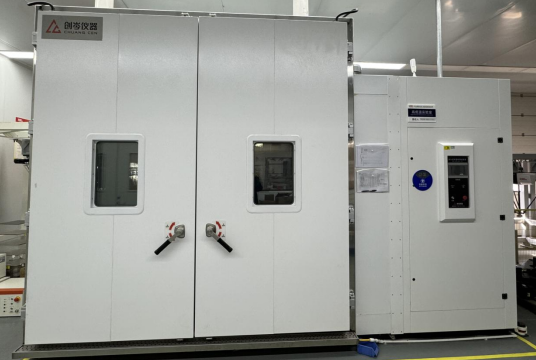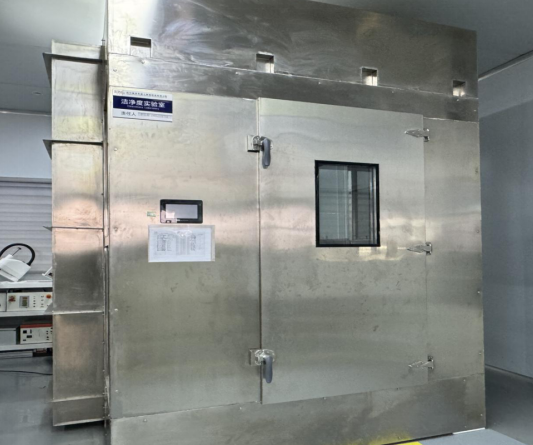Silent Laboratory for Industrial Robots
Laboratory Overview
The Silent Laboratory is a specialized facility designed to minimize noise interference during the testing of industrial robots and their components. It ensures accurate performance assessments by creating a controlled, low-noise or noise-free environment. With an area of 48m², the laboratory features 10cm-thick soundproof walls and 10cm-thick sound-absorbing materials on the ceiling and side walls. This construction helps to maintain precise experimental conditions, ensuring the reliability of noise measurements during robot testing.
Equipped with four Class 2 sound level meters, the lab can measure noise from four directions simultaneously. It also includes a sound calibrator for ensuring the accuracy of the sound level meters.
Functionality
The Silent Laboratory is tailored to perform noise tests on industrial robots, including parallel robots, SCARA robots, and six-axis robots. The test results help identify areas for optimization, allowing for the reduction of noise emissions and enhancing robot performance. The testing methodology follows ISO 3744:2010 standards for noise emission measurement.
The laboratory's sound level meters use advanced 24-bit AD converters and fully digital filters, fully complying with IEC 61672-1:2013 standards for sound measurement.
Relevant Standards
ISO 3744:2010 - Industrial Noise Testing Methods
IEC 61672-1:2013 - Electroacoustics - Sound Level Meters - Part 1: Specifications

High and Low Temperature Laboratory for Robot Performance Testing
Laboratory Overview
The High and Low Temperature Laboratory is designed to simulate extreme temperature conditions to test the reliability and stability of industrial robots, ensuring they perform under diverse environmental stresses. With a temperature range of -40°C to +150°C and a humidity control range of 20% to 98% RH, this laboratory can test robots under various real-world conditions. The laboratory occupies 14m², with inner box dimensions of W2600 x H2700 x D2600mm and an internal volume of 19m³.
The laboratory provides a load-bearing platform for robot testing, with heating and cooling rates that allow for controlled temperature transitions: 3°C/min from room temperature to 150°C, and 1°C/min from room temperature to -40°C.
Functionality
This laboratory performs high-temperature, low-temperature, constant humid heat, and alternating humid heat tests on parallel robots, SCARA robots, and six-axis robots. Such tests help optimize robot performance and ensure that they meet industry standards for temperature and humidity tolerance.
Relevant Standards
IEC 60068-2-1:2007 - Environmental Testing - Part 2: Test Methods - Test A: Cold
IEC 60068-2-2:2007 - Environmental Testing - Part 2: Test Methods - Test B: Dry Heat
IEC 60068-2-78:2012 - Environmental Testing - Part 2: Test Methods - Test Cab: Damp Heat, Steady State
IEC 60068-2-30:2005 - Environmental Testing - Part 2: Test Methods - Test Db: Damp Heat, Cyclic (12h + 12h cycle)


Cleanliness Laboratory for Robotics Applications
Laboratory Overview
The Cleanliness Laboratory ensures that industrial robots are tested in a controlled, dust-free environment to meet stringent cleanliness standards. With an area of 7m², the laboratory features an advanced air treatment and filtration system, as well as pressure and airflow control systems to maintain precise environmental conditions. The core testing area meets ISO Class 3 cleanliness levels. The laboratory is equipped with a dust particle counter, capable of measuring particles across various sizes: 0.3um, 0.5um, 1um, 3um, 5um, and 10um.
Functionality
The Cleanliness Laboratory is used for testing the cleanliness of SCARA robots and six-axis robots to ensure that they can meet the specific requirements of clients in sensitive environments, such as semiconductor manufacturing or cleanroom operations. After each robot undergoes testing in the laboratory, the dust particle counter measures the robot's cleanliness level, comparing it with the appropriate standards from ISO 14644-14:2016.
Relevant Standards
ISO 14644-14:2016 - Cleanrooms and Associated Controlled Environments - Part 14: Evaluation of Equipment Suitability Using Dust Particle Concentration
ISO 21501-4:2007 - Cleanrooms and Associated Controlled Environments - Performance Requirements and Test Methods for Dust Particle Counters
ISO 14644-1:2015 - Cleanrooms and Associated Controlled Environments - Part 1: Classification of Air Cleanliness


By integrating these laboratory testing capabilities into the production process, we ensure that our industrial robots meet the highest standards of noise control, environmental durability, and cleanliness. These comprehensive tests help improve both the quality and performance of the robots, making them more reliable and efficient in various industrial settings.
 Learn More
Learn More 
 EN
EN  ja
ja  ko
ko  fr
fr  de
de  es
es  ru
ru  pt
pt  ar
ar  vi
vi  ur
ur 










